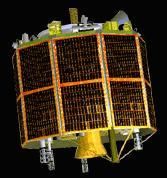
Home - Search - Browse - Alphabetic Index: 0- 1- 2- 3- 4- 5- 6- 7- 8- 9
A- B- C- D- E- F- G- H- I- J- K- L- M- N- O- P- Q- R- S- T- U- V- W- X- Y- Z
MiniSat-400
 SSTL Minisatellite Credit: NASA |
AKA: Minisat SSTL;SSTL 400. Status: Operational 1999. First Launch: 1999-04-21. Last Launch: 1999-04-21. Number: 1 . Payload: 200 kg (440 lb). Gross mass: 400 kg (880 lb).
SSTL's MiniSat-400 platform was a high-capability platform for missions up to 400 kg total mass, with payloads up to 200 kg. SSTL developed this larger platform in response to customers requesting a cost-effective solution for payloads with more demanding mass, volume, power, data-handling and attitude/orbit control requirements.
The MiniSat-400 platform structure was based in part on proven mechanical modules from the MicroSat-70, with three module stacks mounted in a triangular configuration at the heart of the structure. These stacks supported a payload platform providing a large volume for internal payloads, with the possibility of apertures through the side or the top facet of the satellite. The top facet provided a mounting area for external payloads, sensors and antennas. Similarly, the bottom facet had space available for external units and the launcher attach fitting.
Customers could draw upon SSTL's full range of avionics units to configure the MniSat-400 platform. SSTL offered several options for three-axis attitude control, using momentum wheels, reaction wheels or cold-gas thrusters. Key attitude sensors could be selected from a range of proven Earth, Sun, star and magnetic sensors.
The on-board data handling system featured triple redundant internal telemetry and command networks (CAN), parallel on-board computers, Ethernet for high-speed internal communications and either S or X-band downlinks.
Propulsion options included Nitrogen or Xenon cold-gas, resisto-jets and hydrazine based systems, which could be configured for station acquisition, formation flying and end-of-life de-orbiting.
In 1999, SSTL demonstrated the MiniSat-400 bus in orbit on the UoSAT-12 R&D mission. The bus was listed in the NASA Rapid Spacecraft Development Office catalogue for extremely fast procurement by U.S. government agencies.
More at: MiniSat-400.
| UoSat 12 (UO 36, UoSAT-OSCAR 36) / WavSat 2 Null |
Family: Medium earth orbit, Technology, Technology satellite. Country: UK. Launch Vehicles: R-7, R-36M 15A14, Dnepr, Soyuz-FG. Launch Sites: Baikonur, Baikonur LC31, Baikonur LC109. Agency: Surrey. Bibliography: 2, 12840.
 | UoSAT-12 Credit: Manufacturer Image |
1999 April 21 - . 04:59 GMT - . Launch Site: Baikonur. Launch Complex: Baikonur LC109. Launch Pad: LC109/95. LV Family: R-36M. Launch Vehicle: Dnepr.
- UoSAT-12 - .
Mass: 325 kg (716 lb). Nation: UK.
Agency: Surrey.
Manufacturer: Surrey.
Class: Technology.
Type: Navigation technology satellite. Spacecraft: MiniSat-400.
USAF Sat Cat: 25693 . COSPAR: 1999-021A. Apogee: 654 km (406 mi). Perigee: 639 km (397 mi). Inclination: 64.60 deg. Period: 97.70 min.
First launch of Russia's Dnepr launch vehicle, a converted R-36M2 ICBM. The Dnepr was launched from a silo. The third stage maneuvring bus (used on the ICBM for dispensing multiple warheads) placed UoSAT-12 into a 638 km x 652 km x 64.6 deg orbit. The third stage separated from the payload at 05:13 GMT and then made a burn into a 599 km x 1403 km x 64.6 deg orbit. UoSAT-12 was the first test of the Minibus platform, at 325 kg a larger spacecraft than earlier 50 kg Surrey UoSATs. It carried a mobile radio experiment (MERLION), a GPS receiver, and imaging cameras.
Back to top of page
Home - Search - Browse - Alphabetic Index: 0- 1- 2- 3- 4- 5- 6- 7- 8- 9
A- B- C- D- E- F- G- H- I- J- K- L- M- N- O- P- Q- R- S- T- U- V- W- X- Y- Z
© 1997-2019 Mark Wade - Contact
© / Conditions for Use